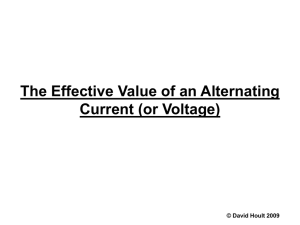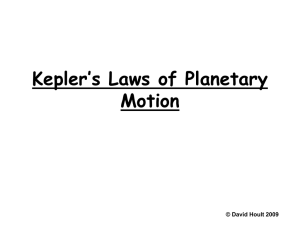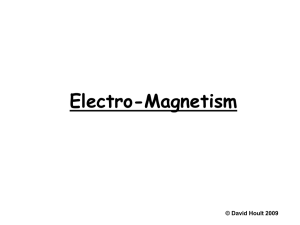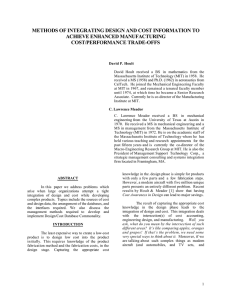Teaching Aid: Gravitation PowerPoint
advertisement
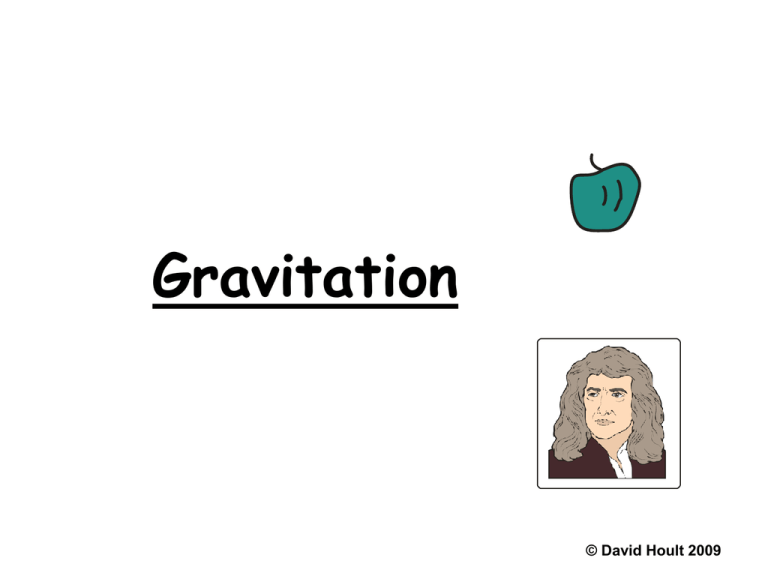
Gravitation © David Hoult 2009 © David Hoult 2009 © David Hoult 2009 © David Hoult 2009 © David Hoult 2009 © David Hoult 2009 © David Hoult 2009 F a m1m2 © David Hoult 2009 © David Hoult 2009 © David Hoult 2009 © David Hoult 2009 © David Hoult 2009 © David Hoult 2009 © David Hoult 2009 1 F a 2 r © David Hoult 2009 F =G m1m2 r2 where G is the universal gravitation constant © David Hoult 2009 F =G m1m2 r2 where G is the universal gravitation constant N m2 kg-2 © David Hoult 2009 Testing the Inverse Square Law of Gravitation © David Hoult 2009 © David Hoult 2009 9.8 -3 ms-2 = 2.72 × 10 602 © David Hoult 2009 9.8 -3 ms-2 = 2.72 × 10 602 v2 a= r © David Hoult 2009 9.8 -3 ms-2 = 2.72 × 10 602 v2 a= r r = 3.84 × 108 m T = 27.3 days © David Hoult 2009 Centripetal acceleration of the moon (caused by the force of gravity) 2.72 × 10-3 ms-2 © David Hoult 2009 Conclusion The inverse square law is a good theory © David Hoult 2009 Relation between g and G © David Hoult 2009 Relation between g and G F g m © David Hoult 2009 Relation between g and G F g m Mm FG 2 R © David Hoult 2009 Relation between g and G F g m Mm FG 2 R M gG 2 R © David Hoult 2009 we have assumed the equivalence of inertial and gravitational mass © David Hoult 2009 Gravitational Field Strength © David Hoult 2009 The g.f.s. at a point in a gravitational field is the force per unit mass acting on point mass © David Hoult 2009 The g.f.s. at a point in a gravitational field is the force per unit mass acting on point mass Units Nkg-1 © David Hoult 2009 “Force per unit mass” is equivalent to acceleration © David Hoult 2009 G.f.s. is another name for acceleration due to gravity © David Hoult 2009 © David Hoult 2009 M gG 2 r © David Hoult 2009 ga 1 r2 © David Hoult 2009 ga 1 r2 © David Hoult 2009 © David Hoult 2009 outside the sphere ga 1 r2 outside the sphere ga 1 r2 © David Hoult 2009 outside the sphere ga 1 r2 inside the sphere g a r © David Hoult 2009 outside the sphere ga 1 r2 inside the sphere g a r © David Hoult 2009 © David Hoult 2009 © David Hoult 2009 World High Jump Record... © David Hoult 2009 World High Jump Record... on Mars ? © David Hoult 2009 © David Hoult 2009 © David Hoult 2009 maximum height, s depends on: © David Hoult 2009 maximum height, s depends on: initial velocity, u © David Hoult 2009 maximum height, s depends on: initial velocity, u acceleration due to gravity, g © David Hoult 2009 u2 = -2gs so, for a given initial velocity © David Hoult 2009 u2 = -2gs so, for a given initial velocity gs = a constant © David Hoult 2009 For a given initial velocity, the maximum height reached by the body is inversely proportional to the acceleration due to gravity © David Hoult 2009 s a 1 g © David Hoult 2009 s a 1 g sg = a constant © David Hoult 2009 s a 1 g gs = a constant g1s1 = g2s2 or s1 g2 = s2 g1 © David Hoult 2009 Gravitational Potential © David Hoult 2009 The potential at a point in a gravitational field is the work done per unit mass moving point mass from infinity to that point © David Hoult 2009 The potential at a point in a gravitational field is the work done per unit mass moving point mass from infinity to that point units of potential J kg-1 © David Hoult 2009 © David Hoult 2009 © David Hoult 2009 © David Hoult 2009 w = Fs but in this situation the force is not of constant magnitude © David Hoult 2009 w = Fs but in this situation the force is not of constant magnitude © David Hoult 2009 It is clear that the work done will depend on: © David Hoult 2009 It is clear that the work done will depend on: the mass of the planet, M © David Hoult 2009 It is clear that the work done will depend on: the mass of the planet, M the distance, r of point p from the planet © David Hoult 2009 It is clear that the work done will depend on: the mass of the planet, M guess: w a M the distance, r of point p from the planet © David Hoult 2009 It is clear that the work done will depend on: the mass of the planet, M guess: w a M the distance, r of point p from the planet guess: w a 1/r © David Hoult 2009 ...it can be shown that... © David Hoult 2009 GM w = r © David Hoult 2009 A body at infinity, has zero gravitational potential “at infinity” means that the body is out of the gravitational field © David Hoult 2009 A body at infinity, has zero gravitational potential “at infinity” means that the body is out of the gravitational field All bodies fall to their lowest state of potential (energy) © David Hoult 2009 A body at infinity, has zero gravitational potential “at infinity” means that the body is out of the gravitational field All bodies fall to their lowest state of potential (energy) All gravitational potentials are therefore negative quantities © David Hoult 2009 V = GM r © David Hoult 2009 V = GM r Therefore the gravitational potential energy possessed by a body of mass m placed at point p is given by © David Hoult 2009 V = GM r The gravitational potential energy possessed by a body of mass m placed at point p is given by GPE = Vm © David Hoult 2009 Escape Velocity © David Hoult 2009 © David Hoult 2009 © David Hoult 2009 © David Hoult 2009 © David Hoult 2009 G P E = zero © David Hoult 2009 G P E = zero To find the minimum velocity, ve which will cause the rocket to escape the Earth’s gravity, assume K E of distant rocket is also equal to zero. © David Hoult 2009 G P E = zero To find the minimum velocity, ve which will cause the rocket to escape the Earth’s gravity, assume K E of distant rocket is also equal to zero. As the body is moving away from the planet it is losing K E and gaining G P E © David Hoult 2009 G P E = zero To find the minimum velocity, ve which will cause the rocket to escape the Earth’s gravity, assume K E of distant rocket is also equal to zero. As the body is moving away from the planet it is losing K E and gaining G P E DKE = DGPE © David Hoult 2009 If the mass of the rocket is m, then the G P E it possesses at the surface of the planet is GPE = GMm R © David Hoult 2009 If the mass of the rocket is m, then the G P E it possesses at the surface of the planet is GPE = GMm R DGPE = GMm r © David Hoult 2009 If the mass of the rocket is m, then the G P E it possesses at the surface of the planet is GPE = GMm R DGPE = GMm R D K E = ½mve2 © David Hoult 2009 ½mve 2 = GMm R © David Hoult 2009 2GM ve R Also, as g = GM/R2 © David Hoult 2009 2GM ve R Also, as g = GM/R2 ve 2gR © David Hoult 2009

